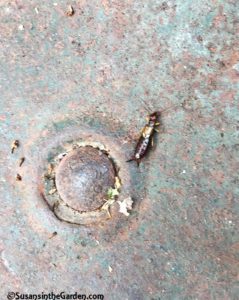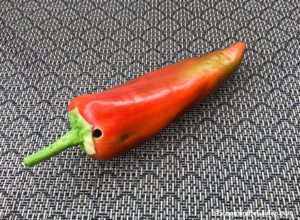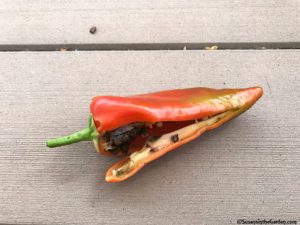Earwigs
Latin name: Forficula auricularia
Size: About 1/2 to 3/4″ long
Color: Dark brown
Life cycle: Just about everyone can identify earwigs, especially by the pincher-like hind end. They are primarily nocturnal, hiding under boards and garden debris during the daytime and are drawn to moist conditions. The females lay a case of eggs in the soil. They hatch as nymphs within the case and are fed by the mother earwig. The nymphs go through 3-4 molts (“instars”). Each female earwig produces a single generation in a year’s time.
Signs of their activity: While they are scary-looking and do cause damage in the garden, earwigs also have a beneficial role. For example, they love to eat aphids. Earwigs can cause damage to soft fruits such as apricots, plums, peaches and strawberries. On corn plants, they like to munch on the silks, which can affect pollination resulting in ears of corn that have big gaps in kernels. They also burrow inside peppers (see both photos, for hole and resulting damage inside).
Typically seen on: Corn stalks, underneath piles of garden debris, some types of flowers and other plants.
Controls: Clean up garden debris. If you have leaking sprinklers or areas that are unnecessarily moist, try to resolve that problem. Do not leave boards on planting beds. That gives earwigs a place to hide during the day.
If trying to diagnose the cause of plant damage, go out at night with a flashlight to see if earwigs (or other insects) are on the plants in question and causing problems. Trap earwigs by placing a layer of corrugated cardboard or sheets of newspaper on the soil in a problem area during the day; leave it in place overnight and pick it up and dispose of it in the morning to trap the earwigs that crawled into the openings before morning. Sprinkle diatomaceous earth around the plant(s) you’re trying to protect. Sprays containing Spinosad are said to be effective but only spray at night and away from any flowers that bees visit as it will kill the bees. Always follow label directions!
Natural predators: Chickens, Tachinid flies.
Additional information: Washington State University Hortsense Earwigs, and University of California Integrated Pest Management Earwigs and PennState Dept. of Entomology European Earwigs.
Back to Organic Pest Control



